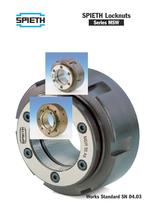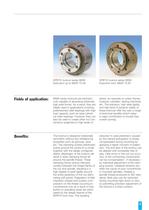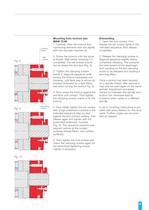Catalog excerpts

Series MSW Works Standard SN 04.03 >
Open the catalog to page 1
SPIETH locknut series MSWExecution up to MSW 70.46SPIETH locknut series MSWExecution from MSW 72.60 > MSW series locknuts are precisionnuts capable of absorbing extremely high axial forces. As a result, they are ideally used in applications involving pretensioned roller bearings with high load capacity, such as axial cylindri- cal roller bearings. However, they can also be used to create other nut con- nections subjected to high levels ofThe locknut is designed rotationallysymmetric without any imbalancing properties such as grooves, slots etc. The clamping screws distributed evenly around...
Open the catalog to page 3
As the effective friction coefficients depend on a range of factors which are often beyond the control of the manufacturer, values specified here are without commitment and are made in the form of recommenda- tions. M M > A : Tightening torque per clampingscrew. The tightening torque is based on a friction coefficient of = 0.14. The axial pretension of a screw con-nection often plays a decisive role for successful function, and must there- fore be set with particular accuracy. However, in most assembly works- hops, direct measurement of this vari- able is not possible, raising the need for...
Open the catalog to page 5
Dismantling First relieve the tension of the clam- ping screws slightly in diagonal sequence. Only then should the clamping screws be completely rele- ased. This prevents the total tension of the diaphragm from working on the last clamping screw to be relea- sed and causing a jamming effect.Once a locknut has been secured on a spindle thread, after removal it may only be used again on the same spindle. Adjustment processes carried out between the spindle and locknut can otherwise lead to problems when using on a different spindle. A set of mounting instructions is provided with every...
Open the catalog to page 8
Dismantling 1. Open the lock screws. First release the set screws lightly in the indicated sequence, then release completely. 2. Release the clamping screws indiagonal sequence slightly before completely releasing. This prevents the total tension of the diaphragm from working on the last clamping screw to be released and causing a jamming effect.Once a locknut has been secured on a spindle thread, after removal it may only be used again on the samespindle. Adjustment processes carried out between the spindle and locknut can otherwise lead to problems when using on a different spindle. A set...
Open the catalog to page 9
Fig. 11:The high load capacity and axial rigidity of the needle axial cylindrical bearing is reliably transmitted to the feed drive system via the mounted locknut. The excellent locking pro- perties provided by the locknut are of major importance under dynamic stress. Fig. 12:Machine frame subjected to high levels of stress. The precise right-angled contact surface of the locknut guarantees that stress is exerted evenly on the bolt thread. There are no bending moments occurring. This is a particu- lar advantage in applications invol- ving dynamic stress. 10 >
Open the catalog to page 10
Fig. 13: In the upper dimension range (from MSW 72.60), the required degree of axial pretension cannot be applied using the locknuts own pretension moment due to the size of the friction radii. Here, axial pretension is applied by integrated set screws. Fig. 14: Piston fixture with locknut. This appli- cation utilizes all the technical benefits of locknuts: Load capacity, axial rigidity and excellent locking properties. 11 >
Open the catalog to page 11All SPIETH-MASCHINENELEMENTE GmbH & Co KG catalogs and technical brochures
-
catalogue
98 Pages
-
Application documentation
20 Pages
-
Clamping Nuts
8 Pages
-
Radial Plain Bearings
6 Pages
-
Guide Gibs
8 Pages
-
Guide Bushings
16 Pages
-
Clamping Sets
22 Pages
-
Locknut
22 Pages
-
Introduction
11 Pages
Archived catalogs
-
Product Range
8 Pages
-
Tension Nut Type AM
8 Pages
-
Precision Locknut MSR/MSA
12 Pages




















